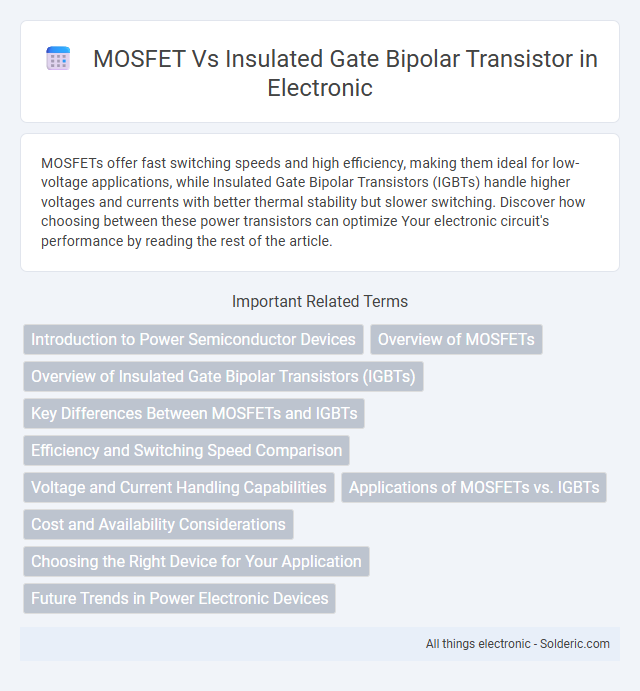MOSFETs offer fast switching speeds and high efficiency, making them ideal for low-voltage applications, while Insulated Gate Bipolar Transistors (IGBTs) handle higher voltages and currents with better thermal stability but slower switching. Discover how choosing between these power transistors can optimize Your electronic circuit's performance by reading the rest of the article.
Comparison Table
| Feature | MOSFET | Insulated Gate Bipolar Transistor (IGBT) |
|---|---|---|
| Type | Voltage-controlled transistor | Voltage-controlled bipolar transistor |
| Operating Voltage | Low to medium (up to ~250V typical) | Medium to high (up to several kV) |
| Switching Speed | Very fast switching (nanoseconds) | Moderate switching speed (microseconds) |
| Conduction Loss | Low conduction loss at low voltages | Lower saturation voltage at high currents |
| Gate Drive | High input impedance, simple drive | Requires higher gate charge, slightly complex drive |
| Thermal Performance | Better at low power levels | Better for high power, high temperature applications |
| Applications | Low voltage power supplies, high frequency circuits | Motor drives, inverters, high power electronics |
Introduction to Power Semiconductor Devices
Power semiconductor devices such as MOSFETs and Insulated Gate Bipolar Transistors (IGBTs) are essential for efficient switching in power electronics, enabling high-speed operation with minimal losses. MOSFETs offer low on-resistance and fast switching suitable for low-voltage applications, while IGBTs provide higher voltage handling and current capabilities ideal for medium- to high-power scenarios. The choice between MOSFETs and IGBTs depends on factors like switching frequency, voltage ratings, and thermal performance for optimal power management in industrial and automotive systems.
Overview of MOSFETs
MOSFETs (Metal-Oxide-Semiconductor Field-Effect Transistors) are widely used in low-voltage, high-frequency switching applications due to their fast switching speeds and high input impedance. They operate by controlling the voltage applied to the gate terminal to regulate current flow between the drain and source terminals. Your choice of MOSFET provides advantages in power efficiency and thermal performance for digital circuits and power management systems.
Overview of Insulated Gate Bipolar Transistors (IGBTs)
Insulated Gate Bipolar Transistors (IGBTs) combine the high input impedance and fast switching of MOSFETs with the high current and low saturation voltage capabilities of bipolar transistors, making them ideal for high-power applications. IGBTs excel in efficiency and robustness in motor drives, inverters, and power grid systems, handling voltages typically ranging from 600V to 1.7kV. Your choice between MOSFETs and IGBTs should consider switching speed, voltage, and current requirements to optimize performance and cost.
Key Differences Between MOSFETs and IGBTs
MOSFETs (Metal-Oxide-Semiconductor Field-Effect Transistors) offer faster switching speeds and lower conduction losses, making them ideal for high-frequency applications and low-voltage circuits. IGBTs (Insulated Gate Bipolar Transistors) handle higher voltages and currents with better efficiency in medium- to high-power applications but switch slower compared to MOSFETs. Your choice between MOSFETs and IGBTs depends on specific requirements like switching speed, voltage rating, and power efficiency for optimal circuit performance.
Efficiency and Switching Speed Comparison
MOSFETs exhibit higher switching speeds due to their majority carrier operation, enabling rapid charge and discharge cycles, which enhances efficiency in high-frequency applications. Insulated Gate Bipolar Transistors (IGBTs), while capable of handling higher voltage and current levels, have slower switching speeds because of their minority carrier injection, resulting in increased switching losses. For applications requiring fast switching and better efficiency at lower voltages, MOSFETs are preferred, whereas IGBTs are optimal for high-power, low-frequency environments despite lower efficiency.
Voltage and Current Handling Capabilities
MOSFETs excel in high-frequency switching with voltage ratings typically ranging from 20V to 1000V and current capabilities suited for low to medium power applications, often up to hundreds of amperes. Insulated Gate Bipolar Transistors (IGBTs) are designed for high voltage and high current applications, commonly handling voltages from 600V to 6500V and currents exceeding several hundred amperes, making them ideal for industrial motor drives and power inverters. The MOSFET's fast switching and lower conduction losses contrast with the IGBT's superior performance in high voltage, high current environments where switching speeds are less critical.
Applications of MOSFETs vs. IGBTs
MOSFETs are primarily used in high-frequency and low-voltage applications such as power supplies, DC-DC converters, and RF amplifiers due to their fast switching speed and high efficiency. IGBTs excel in high-voltage, high-current applications like motor drives, induction heating, and power inverters because of their superior conduction capabilities and robustness. The choice between MOSFETs and IGBTs depends heavily on voltage, current requirements, and switching frequency in the specific application.
Cost and Availability Considerations
MOSFETs generally offer lower cost and higher availability due to widespread use in consumer electronics and industrial applications, making them a budget-friendly option for many designs. Insulated Gate Bipolar Transistors (IGBTs), while often more expensive and less readily available, excel in high-voltage and high-current applications, justifying their premium price in power-intensive systems. Your choice between MOSFET and IGBT may hinge on balancing budget constraints with performance requirements specific to cost and supply factors.
Choosing the Right Device for Your Application
Choosing between a MOSFET and an Insulated Gate Bipolar Transistor (IGBT) depends on your application's voltage and switching frequency requirements. MOSFETs excel in low-voltage, high-frequency scenarios due to their fast switching capabilities and lower conduction losses, making them ideal for applications like DC-DC converters and motor drives. IGBTs are better suited for high-voltage, high-current applications such as industrial motor control and power inverters, where their robustness and efficiency at switching frequencies below 20 kHz provide superior performance.
Future Trends in Power Electronic Devices
Future trends in power electronic devices highlight the growing prominence of wide-bandgap semiconductors such as SiC MOSFETs and GaN HEMTs, which offer superior efficiency and higher switching frequencies compared to traditional IGBTs. Your choice between MOSFETs and IGBTs will increasingly depend on application-specific requirements, with MOSFETs favored for high-speed, low-voltage scenarios and IGBTs remaining competitive in high-power, high-voltage applications. The integration of advanced packaging and thermal management techniques further propels the performance capabilities of both device types in evolving power electronics markets.
MOSFET vs Insulated Gate Bipolar Transistor Infographic

 solderic.com
solderic.com